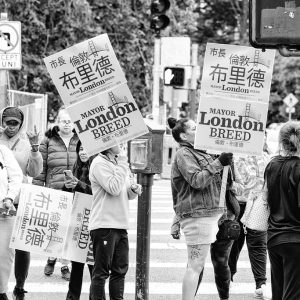In California, one in six construction workers has fallen into the underground economy. Source: Bloomberg/United States Department of Labor
Imagine the underground. Dirt, rocks, dark tunnels. All activity is below the surface—subterranean. The underground is hidden, furtive, and secretive. Now imagine underground economic activity. Literally, it may be exchanges that take place below the ground, unseen and undocumented. Specifically in the context of California, it refers to, according to the state’s Board of Equalization, “people who steal, make counterfeit products, engage in human trafficking, and hide what they owe in taxes.” A significant sector of this underground economy is construction work.
According to the Economic Roundtable, a nonprofit research organization that focuses on public policy, California’s construction industry is worth $152 billion and employs 865,000 construction workers. A 2014 study done by the organization shows that the number of construction workers entering California’s underground economy has increased, especially over the past couple of decades. Since 1972, the percentage of those in the underground construction industry has increased by 400 percent. In 2011, 104,100 construction workers were unreported by their employers, while 39,800 were misclassified as independent contractors, making up a total of 143,900 construction workers entering the underground economy that year. Today, one out of six construction workers is estimated to have fallen into the underground economy.
One cause of current, ongoing increases in the number of construction workers participating in the underground economy certainly lies in the Great Recession. Even before the Great Recession, California’s unemployment rate was above the national rate—in fact, because the state’s population has grown faster than the rate at which the state’s economy generates jobs, California’s rate of unemployment has been higher than the national rate for over 20 years. The Great Recession heightened competition for these jobs as the construction industry experienced the most contraction. The recent housing market slump contributed to great decreases in the construction of new residential housing. Many jobs in the formal construction industry were lost—and one-third still have not been recovered, incentivizing construction workers to enter the underground economy. However, economic causes also have economic consequences.
While economic recessions have perpetuated declines in the construction industry, economic dynamics are also impacted by changes in the underground economy. “Under the table” cash transfers from employers to construction workers of the underground economy are often not reported on tax forms. According to the Economic Roundtable study, both the federal and state governments have lost hundreds of millions of dollars because of this. These lost tax revenues take away from funding of public services and programs such as unemployment insurance and workers’ compensation. This is not all. These activities allow those in the informal economy to “have an illegal, unfair advantage over honest businesses” by offering construction services at lower prices. As a whole, this type of action impacts the entire construction sector and state economy.
Social consequences have also arisen. First, as previously mentioned, a bulk of construction workers participating in the underground economy is not reported by their employers. An increase in workers participating in the underground construction industry means more workers are likely to be without proper workers’ insurance and are more vulnerable to compensation violations. Second, in efforts to maintain their livelihoods and to rise out of poverty, construction workers join the ranks of the underground and take jobs they might not be able to find in the legitimate economy. These workers take the work of those above ground, affecting others’ families and lives. Furthermore, these construction workers who engage in activity within the underground realm earn less—they make only 50 to 60 percent of what those in the formal sector do. In contrast to their initial goals, construction workers who enter the informal economy may very well remain in poverty, which may lead to familial stress or interpersonal conflicts. In the past, the construction industry may have been seen as a way to move up the social ladder. Today, for those participating in the underground construction industry, it is not necessarily so.
To address the ongoing problems, some work in government is already being done to assist workers participating in the underground economy. Numerous state organizations have continued to protect workers and combat activities of the underground economy. One such organization, the Employment Enforcement Task Force (EETF), works with the Contractors State License Board (CSLB) to regulate the California’s construction industry. In 2014, the California Governor signed off on legislation to aid victims of the underground economy by “expedit[ing] hearings for injured employees of employers that are illegally operating without workers’ compensation insurance,” and thus allowing expedited access to medical care for workers who would typically not have a safety net. Additionally, the law eases the process of identifying and taking action against employers who are not playing by the rules. The state has also launched educational campaigns to inform workers about workplace regulations and wage theft. All this greatly applies to the underground construction industry, and these political actions are gradually helping to reverse current trends by empowering construction workers to defend their own rights.
Yet, more needs to be done—and there have been various proposed solutions to deal with the growing number of construction workers entering the underground economy. Most involve legal relief political action that helps to curb underground economic activity and protect the rights of construction workers. One such solution is increased publicity to shed light on the illegal economic activities in the construction industry such as employers’ neglect in reporting their workers. Another proposed solution is an economic one—raising the wage floor to ensure all workers—especially those involved in the informal economy—are paid a fair wage. This would help to reduce abuses by employers and would, to an extent, mitigate extreme poverty levels among underground construction workers. In conjunction with these is the proposed solution of strengthening labor unions. Power to construction labor unions would encourage more workers to join them. Stronger representation for all construction workers would help ensure that labor standards be respected and enforced, mitigating employers’ potentially adverse actions toward construction workers in the underground industry. Finally, there has been an emphasis on greater education and training overall. Not only were those with higher levels of education relatively protected in the Great Recession, but the service and professional industries that continue to expand call for highly educated workers. Instead of being pushed into unemployment or work in the underground economy, more highly skilled workers would be able to find jobs in other industries.
As the economy and society change, the overall issue of the underground construction industry remains complex and multi-faceted. The interplay of varying dynamic factors contributes to the ongoing increases in construction workers joining the underground. Likewise, there is not necessarily a single solution. The current efforts and proposed solutions are not mutually exclusive—they are reinforcements of each other and have the potential to work together to address the economic and social parts of the problem by assisting workers and in turn reducing economic losses—because, indeed, the underground can be dark, secret, and incredibly pernicious.





